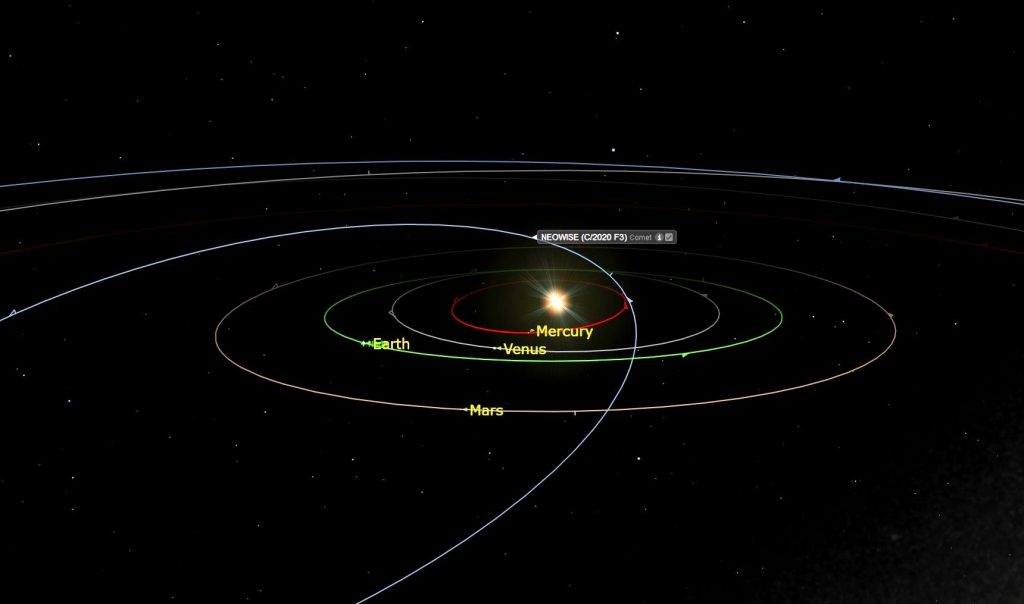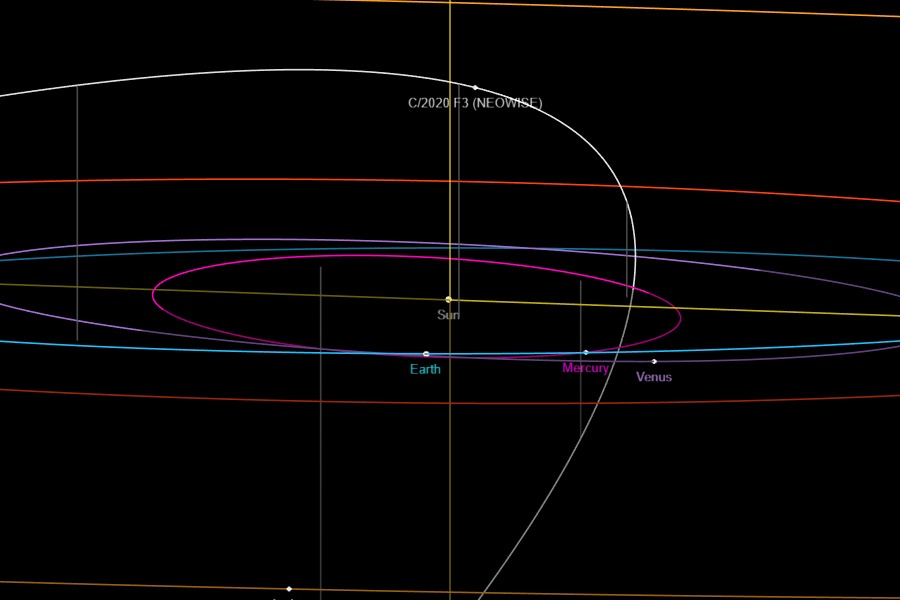NEOWISE swept within Mercury’s orbit a week ago and now it is streaking past the earth. Its close proximity to the sun caused dust and gas to burn off its surface and create an even bigger debris tail. Now the comet is headed our way. At the beginning of the month, the comet was visible just before the sunrise. The recently discovered comet called C/2020 F3, also known as NEOWISE after the NASA telescope that discovered it, will make its closest approach to the Earth on July 22. On the day, the comet, which takes 6,800 years to complete one lap around its orbit, will be at a distance of 64 million miles or 103 million kilometers while crossing Earth.
Comet C/2020 F3 (NEOWISE) is currently in the constellation of Scorpius. The current Right Ascension of Comet C/2020 F3 (NEOWISE) is 15h 50m 19s and the Declination is -28° 06’ 51” (topocentric coordinates computed for the selected location: Greenwich, United Kingdom [change]). The current estimated magnitude of Comet C/2020 F3 (NEOWISE) is 23.06 (JPL).
Summary of key facts about Comet C/2020 F3 (NEOWISE) [tip: you can also create a Quick Access page for this data if you access it frequently and would like to have a simpler view]:
- C/2020 F3 (NEOWISE) isbelow the horizon from Greenwich, United Kingdom [change].
- Given its current magnitude, C/2020 F3 (NEOWISE) is visible only through long exposure photography.
- See also C/2020 F3 (NEOWISE) rise and set times.
- Go to interactive sky chart
If you need to access this information frequently for your observations, you can create a simple customized Quick Access page, so that you can easily bookmark it in your browser favorites or add a shortcut to your mobile phones' home screen.

Additional information about Comet C/2020 F3 (NEOWISE) available on TheSkyLive:

- Position and finder charts (see also Where is Comet C/2020 F3 (NEOWISE)?)
- Distance from Earth (see also How far is Comet C/2020 F3 (NEOWISE) from Earth?)
- Rise and set times (see also When does Comet C/2020 F3 (NEOWISE) rise and set?)
- Brightness (see also How bright is Comet C/2020 F3 (NEOWISE)?)
- Orbital elements. Detailed information about Comet C/2020 F3 (NEOWISE) orbital parameters.
- Interactive orbit visualization. 3d visualization showing the orbit of Comet C/2020 F3 (NEOWISE) with respect to the major Solar System objects.
- 15 days ephemerides. Table showing celestial coordinates and magnitude of Comet C/2020 F3 (NEOWISE) for the past and next 7 days.
- Interactive sky chart. An online planetarium application that shows where to locate Comet C/2020 F3 (NEOWISE) in the sky from your location.
- Live position tracker. A high precision sky chart that uses real deep sky imagery to help locate Comet C/2020 F3 (NEOWISE) with your telescope or on your astrophotographies.
Below we provide Comet C/2020 F3 (NEOWISE) finder charts showing where the object is right now in the sky with respect to the brightest stars. The first finder chart has a field of view of 50 degrees, while the second one has a field of view of 10 degrees. Click on each finder chart to access a full screen interactive Online Planetarium.
Field of view: 50x30 degrees
View fullscreen
Field of view: 10x6 degrees
View fullscreen
= binocular, brighter than 10th magnitude
Location: Greenwich, United Kingdom [change]
Higher precision deep sky finder chart, 60 arcmin wide, showing where Comet C/2020 F3 (NEOWISE) is right now. Click on the image to see a more detailed fullscreen tracker view.
RA: 15h 50m 19s
Dec: -28° 06’ 51”
Field of view: 60x40 arcmins
View fullscreen
Also check out Where is Comet C/2020 F3 (NEOWISE)?, a page that provides all the information needed to find Comet C/2020 F3 (NEOWISE) in the sky and additional links to sky charts.
The distance of Comet C/2020 F3 (NEOWISE) from Earth is currently 551,242,268 kilometers, equivalent to 3.684827 Astronomical Units. Light takes 30 minutes and 38.7463 seconds to travel from Comet C/2020 F3 (NEOWISE) and arrive to us.
The following chart shows the distance of Comet C/2020 F3 (NEOWISE) from Earth as a function of time. In the chart the distance data is measured in Astronomical Units and sampled with an interval of 1 day.
The value of the reported distance might be somewhat inaccurate around the times of closest approach for objects passing extremely close to Earth. The value of the distance of C/2020 F3 (NEOWISE) from Earth is also available as a real time updated value in the Live Position and Data Tracker.
Between January 2013 and December 2100, the closest approach of Comet C/2020 F3 (NEOWISE) to Earth happens on Thu Jul 23 2020 at a distance of 0.691854 Astronomical Units, or 103,499,929 kilometers:

NOTE: values for the closest approach are computed with a sampling interval of 1 day.
The current visual magnitude of Comet C/2020 F3 (NEOWISE) is 23.06.
The observed magnitude and coma diameter values are derived from the Comet Observers Database by averaging the values reported in recent observations (more recent than 4 days), when available. The Estimated Magnitude comes from the JPL Horizons ephemerides service and might be inaccurate given the highly dynamic and unpredictable behavior of comets. When available, please refer to the Observed Magnitude value and consider the Estimated Magnitude as a directional indication. We acknowledge with thanks the comet observations from the COBS Comet Observation Database contributed by observers worldwide and used in this table to report recent comet observations.
The following chart is the predicted light curve (visual magnitude as a function of time) of Comet C/2020 F3 (NEOWISE), according to the most recent ephemerides data. Magnitude data is sampled with a 2 days interval and there might be inaccuracies for objects changing brightness very rapidly during the course of a few days. For comets there could be large discrepancies between the observed and predicted brightness because of their highly dynamic behaviour.
Location: Greenwich, United Kingdom [change]
Latitude: 51° 28’ 47” N
Longitude: 0° 00’ 00” E
Timezone: Europe/London

Today's Comet C/2020 F3 (NEOWISE) rise, transit and set times from Greenwich, United Kingdom [change] are the following (all times relative to the local timezone Europe/London):
The rise and set times are defined as the time at which the upper limb of Comet C/2020 F3 (NEOWISE) touches the horizon, considering the effect of the atmospheric refraction. As the atmospheric conditions cannot be modeled precisely the times reported here should be considered correct with an approximation of few minutes.
The following table lists the orbital elements of Comet C/2020 F3 (NEOWISE) at epoch 12 July 2020 00:00 UTC (JD: 2459043.5). Source: JPL Small-Body Database
| Element | Symbol | Value |
|---|---|---|
| Orbit eccentricity | e | 0.99918806 |
| Orbit inclination | i | 128.93729255° |
| Perihelion distance | q | 0.29464934 AU 44,078,913 km |
| Aphelion distance | Q | 725.49838785 AU 108,533,014,237 km |
| Semi-major axis | a | 362.89651860 AU 54,288,546,575 km |
| Orbital period | period | 6,913.2500 years 2,525,065.3925 days |
| Date of perihelion transit | Tp | 2020-Jul-03 16:17:55 2,459,034.1791 JD |
| Next perihelion transit | 8933-Nov-25 01:43 4,984,099.5716 JD | |
| Argument of perihelion | peri | 37.27889886789° |
| Longitude of the ascending node | node | 61.010544954003° |
| Mean anomaly | M | 0.0013288840490607° |
| Mean motion | n | 0.00014257°/day |
This 3d orbit diagram is a feature of our 3D Solar System Simulator and shows the orbit of Comet C/2020 F3 (NEOWISE) with respect of the Sun and the orbits of the major planets. The position of Comet C/2020 F3 (NEOWISE) and the planets along their orbits in this diagram accurately represents the current configuration of the objects in the Solar System. This is an experimental feature and it requires a WebGL enabled browser. Please provide us feedback!
View Comet C/2020 F3 (NEOWISE) in the 3D Solar System Simulator
The following table lists the ephemerides of Comet C/2020 F3 (NEOWISE) computed for the past and next 7 days, with a 24 hours interval. Click on each row of the table to locate Comet C/2020 F3 (NEOWISE) in our Online Planetarium at the chosen date.
| Date | Right AscensionR.A. | DeclinationDec. | MagnitudeMag | Constellation |
|---|---|---|---|---|
| 2021 Apr 19 | 15h 58m 41s | -28° 10’ 27” | 22.96 | Scorpius |
| 2021 Apr 21 | 15h 56m 12s | -28° 09’ 50” | 22.99 | Scorpius |
| 2021 Apr 23 | 15h 53m 40s | -28° 08’ 48” | 23.02 | Scorpius |
| 2021 Apr 25 | 15h 51m 06s | -28° 07’ 22” | 23.05 | Scorpius |
| 2021 Apr 27 | 15h 48m 33s | -28° 05’ 31” | 23.07 | Scorpius |
| 2021 Apr 29 | 15h 45m 56s | -28° 03’ 16” | 23.10 | Libra |
| 2021 May 01 | 15h 43m 19s | -28° 00’ 38” | 23.13 | Libra |
Additional Information
Neowise Orbital Period
An orrery is a model of the solar system that shows the positions of the planets along their orbits around the Sun.
The chart above shows the Sun at the centre (the yellow ball), surrounded by the solar system's innermost planets.
Click and drag the chart to rotate the camera angle, or use your mouse wheel to zoom in and out. Alternatively, you can use the slider below the chart to adjust the zoom level. As you zoom out, the solar system's outer planets – Jupiter, Saturn, Uranus and Neptune – will come into view.
The date slider lets you move forwards or backwards by a few months to see the motion of the planets along their orbits over time.
Neowise Orbit Time
The top panel shows where the planets appear in the night sky, as seen from the Earth. The yellow line marks the zodiac – the annual path of the Sun across the sky – and the grey lines show constellation boundaries.
Comet Neowise Orbital Path Diagram
The color coding of the orrery indicates the time of day when each planet is visible. This depends on the direction in which the planet lies, as seen from the Earth. If our line of sight to a planet is widely separated from our sight-line to the Sun, the planet will be easily visible for much of the night. If not, the planet will appear very close to the Sun.

Areas of the chart above which are shaded green are easily visible from the Earth; areas which are red are hidden by the Sun's glare. Areas which are dark blue are visible in the morning sky, while areas which are light blue are visible in the evening sky. This color coding can be turned off by deselecting the option 'Overlay planet visibility'.
By selecting the option 'Mark perihelion / aphelion', labels can be added which mark the closest and further points from the Sun along the orbits of each of the planets. The Earth's orbit is additionally labelled with the points it passes on the first day of each month as it makes its annual circuit around the Sun.
